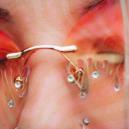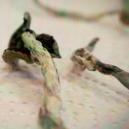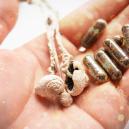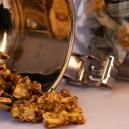A Guide To Growing Magic Mushrooms Outdoors
Published : November 27th, 2018

If you grow magic mushrooms, it’s likely that you do so indoors. But have you ever considered growing mycelium outdoors as well? When you grow mushrooms in your backyard or a similar location outdoors, this can have a number of advantages. You could grow a whole year’s supply of shrooms and it will be less costly!
Growing magic mushrooms isn’t particularly difficult, especially if you grow your shrooms with a fully equipped grow kit. But if you want to grow shrooms from spores, there can be a learning curve and it can take a little more work. One of the biggest considerations when you grow mushrooms is to avoid contamination with mould. This is why you want to choose a good spot where you can grow your shrooms without risk. With a suitable outdoor patch in your garden or backyard for growing, you don’t need to worry about this and can look forward to good yields.
If you want to grow magic mushrooms outdoors, you don’t even need to have your own garden. You could find a nice secluded spot in the forest as well. This comes with the benefit that your mushroom spores will be freely spreading in the area, creating a “magic spot” where your shrooms will grow naturally over time!
SOME BASICS ABOUT GROWING MUSHROOMS
As mentioned, growing mushrooms fortunately isn’t rocket science. But if you want to do it right so you can avoid any potential problems that would spoil your harvest, it can be helpful to know some basics about mushroom cultivation. So before we get more into detail for our outdoor mushroom grow, let’s look at some shroom facts first.
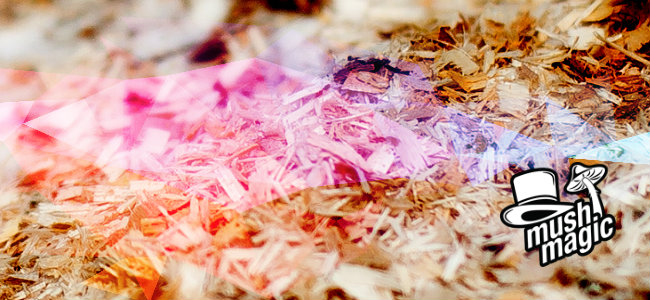
MYCELIUM
Firstly, it is important to know that the part growing out from the substrate—the part with the stem and the cap—is not the actual “mushroom”, but the fruiting body of the organism. The real thing is what grows underneath, called the mycelium. This is the white web, which grows through the substrate. So, if you want to grow mushrooms successfully, what you are really doing is creating an optimal environment for your mycelium to grow.
MUSHROOM SPAWN
Whether you’re growing your shrooms indoors or out, you are going to a need a mushroom spawn. The spawn is any type of substrate, such as rye, sawdust, or wood chips, which is colonised with the mycelium.
WHERE DO YOU GET A MUSHROOM SPAWN?
The easiest way to source a mushroom spawn is with a mushroom grow kit. These grow kits normally come with a substrate that’s already fully colonised. You can use the spawn from the kit to colonise any other suitable substrate, such as if you have a bag of wood chips or sawdust that you want to colonise.
Another method is to inoculate a bag of sterile grain or another substrate with a spore syringe. No matter what, when you have a spawn, either from a grow kit or a colonised a bag of substrate, you can always spread the mycelium. And this is what we will be doing for our outdoor mushroom grow. We’ll be getting to this in a moment.
Most grow kits use grain as a mushroom substrate. The reason here is that grain also contains nutrition for the fungus, which makes it an ideal medium. Great for an indoor grow, but not so much for an outdoor mushroom grow. This is because grain is more susceptible to contamination from bacteria and other unwanted pathogens. But you can transfer a grain spawn to sawdust. Sawdust has a lower risk for infection, which makes it better suited for the outdoors. Moreover, if you want to prepare a nice growing patch outdoors, you will need more colonised substrate anyway. So by transferring the grain spawn to sawdust, you are also “multiplying” it for your purposes.
HOW TO TRANSFER YOUR GRAIN MUSHROOM SPAWN INTO SAWDUST
This process is quite easy. In addition to your grain spawn from your grow kit, you will need a bag of sawdust. You can get sawdust in most pet shops. The sawdust will likely not be sterile, so you have to sterilise it first. For this, immerse the sawdust in a bucket of boiling water for about 10 minutes.
After you have sterilised your sawdust, drain the water. Use another bucket and start layering the sawdust with your inoculated grain: Do multiple layers and cover each layer of grain with sawdust, until you have used up the sawdust or have made the desired amount. Now, use a plastic bag or a lid to cover the bucket that contains your layered mix of sawdust and grain. Make sure to open the lid once per day so that oxygen can enter. This way, you can prevent the growth of mould. After several weeks, the sawdust in the bucket will be completely colonised and ready for the outdoors. As a rule, you will need about 1.2kg of colonised sawdust spawn per square metre for your outdoor mushroom patch.

FINDING A GOOD OUTDOOR SPOT FOR YOUR MUSHROOMS
INDIRECT DAYLIGHT
Magic mushrooms love spots with indirect sunlight. They do love the sun, but then they also don’t want to be exposed to direct sunlight for an extended period. A somewhat shaded area where your mushrooms can still get enough sunlight throughout the day is ideal.
Out in the wild, you can often find mushrooms growing at the border of wooded areas, where grass and shrubs meet. You can look for these types of areas to find a spot.
SLOPES AND SWALES
Natural slopes and swales are also where mushrooms often grow in the wild. These spots normally have a subsurface flow of water, which greatly benefits the growth of the mycelium.
ACCESSIBILITY
Yet another important factor for your outdoor magic mushroom grow should be accessibility. So a spot that requires a long journey each time you want to visit won’t be of much use. The reason for this is that mushrooms can fruit very fast, sometimes literally overnight. When harvest time comes around, you may want to check on your shrooms daily. If the spot is too far out of your way, you may risk missing a harvest.
HOW TO CREATE YOUR MUSHROOM PATCH
When you have finally found a good spot, you want to make it into an optimal growing patch for your magic mushrooms. For this, you will need the following things:
- Your fully colonised sawdust spawn
- Sterile wood chips
- Cardboard
- Small shovel (optional)
- Watering can or garden sprayer (optional)
- Straw or hay (optional)
HOW TO PREPARE YOUR PATCH
- Clear the entire spot of debris. With a shovel or your hands, you should also dig as far down until there is nothing but plain earth. By removing all excess dirt and debris from the area, you reduce the risk for contamination and can make sure that your mycelium grows optimally without competition.
- Line the cleared spot with cardboard and place a 5cm-thick layer of sterile wood chips on the cardboard and spread it out evenly.
- Moisten this first layer of wood chips. Use a watering can or a sprayer for this. If you’re preparing your grow spot in your own backyard, you can just use a garden hose.
- Spread the first layer of sawdust spawn evenly on the moist wood chips. For each layer, use about 400g of spawn per square metre.
- Cover this layer of sawdust spawn with another layer of wood chips. The layer should be about 7cm thick.
- Use the hose or the watering can again and moisten this layer. Place another layer of spawn on the moistened wood chips.
- Place a 3cm layer of wood chips on top.
- Once again, moisten the wood chips and cover with another layer of spawn just like before.
- At this point, you should have done 3 layers of wood chips and 3 layers of spawn. Moisten the entire spot once more with some water.
- Put a cardboard layer on top to keep the moisture in.
- If you want an extra layer of protection for your mushroom grow spot, you can cover the bed with straw or hay. However, if you want to do this, you need to use sterilised straw—sterilised with boiling water in a bucket, just as you did before when you sterilised the sawdust. If you use unsterilised straw, there is a good chance that the straw contains all kinds of fungus that may overgrow your mushroom mycelium. This is not what you want.
Now, when you’re done with your outdoor mushroom patch, all you need is some patience. Leave the growing patch undisturbed for at least 6 months. In this time, the mycelium will colonise all the wood chips in your growing location. Sit back, relax, and look forward to an awesome outdoor harvest!

WHAT IS THE BEST TIME TO PREPARE YOUR OUTDOOR MUSHROOM GROWING PATCH?
Most types of cubensis will fruit in late fall or early winter. Since it will take about 6 months for your growing location to be fully colonised, a good time to make your outdoor patch is likely in early spring, around March in the Northern Hemisphere. But you need to also take into account the time it will take to colonise your sawdust spawn. You want to do this ahead of time before you head out into the wild in spring. A good time to inoculate your sawdust can be in January. If you do it this way, you can plan your outdoor mushroom grow for a fall harvest.
SOME EXTRA TIPS
Most of the time, if you have found a good spot and have brought out your spawn as we explained in our guide, you shouldn’t be required to do anything further. Mother Nature will do the rest and will reward you with plenty of shrooms come harvest time. But there can be times when you want to take some extra care so that your shrooms are guaranteed to grow well. For example, if the season is unusually dry in summer, you may want to water your bed once in the morning and once in the evening.
When harvest time comes around, make sure that you check on your mushrooms frequently, preferably every day. This way, you won’t miss out on some sprouted magic! Likewise, if you are harvesting your magic mushrooms, look out for anything else that might be growing alongside with them. No matter how careful you planned everything, there is always a risk that invasive species may grow as well. Needless to say, you don’t want to consume those!













